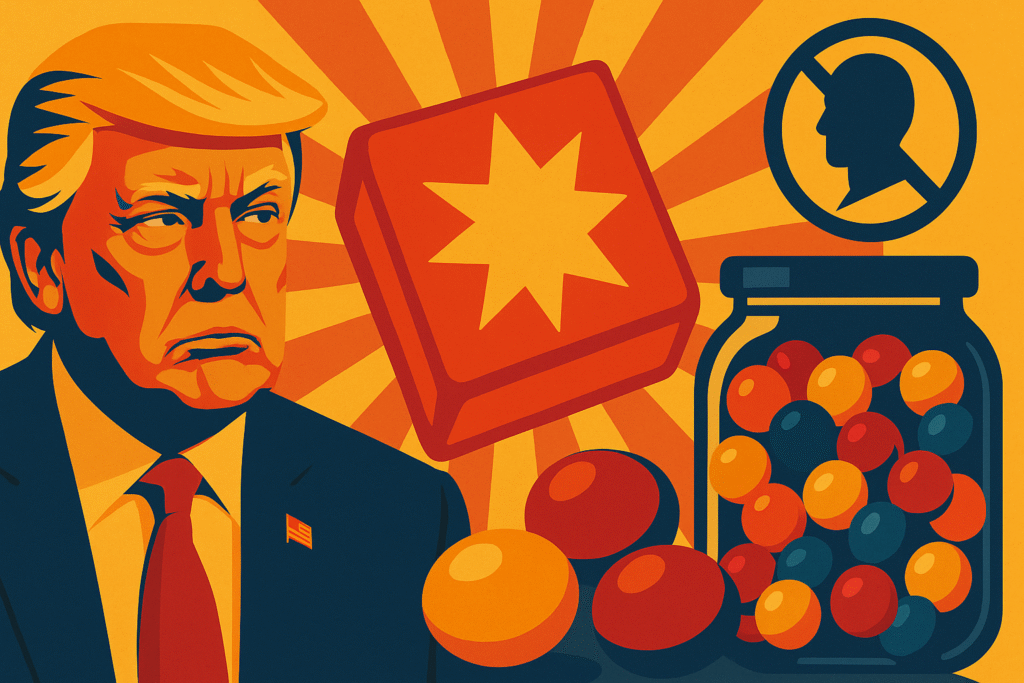Former President Donald Trump’s well-known sweet tooth, famously indulged with pink Starbursts and Tootsie Rolls, could be in conflict with the health initiatives of his own Health and Human Services (HHS) Secretary, Robert F. Kennedy Jr.
At the center of the brewing tension is Mars Wrigley—the maker of Starburst, Skittles, and M&Ms—which has resisted calls to eliminate artificial food dyes from its products. Kennedy, leading the “Make America Healthy Again” (MAHA) initiative, has made the removal of artificial additives a cornerstone of his health reform efforts.
Mars Wrigley Hesitant to Commit to Dye Removal
Mars Wrigley told USA TODAY it is “exploring” dye-free alternatives but has not made firm commitments, citing the lack of fully effective solutions. The company said that while it aims to offer more dye-free options in the near future, its internal research suggests American consumers—unlike those in Europe—are generally unbothered by synthetic dyes in candy.
Kennedy’s HHS, however, has already moved to phase out eight artificial dyes by the end of 2026. These dyes are widely used in candy, soft drinks, and packaged foods and have been linked to behavioral issues in children by the California EPA and other studies. Several states, including California, West Virginia, Virginia, and Utah, have introduced or passed bans or restrictions on such additives in school meals.
Despite lacking formal legislation, Kennedy claims a “mutual understanding” with food manufacturers to phase out the dyes voluntarily. Major food companies like Kraft Heinz, Nestlé, Hershey’s, General Mills, and Tyson Foods have committed to removing artificial dyes in the coming years. Mars’ hesitance makes it a notable holdout.
Public vs. Policy: Trump’s Candy Diplomacy and Personal Preferences
Trump’s fondness for candy is well documented. During a White House event, Press Secretary Karoline Leavitt said he consumes a “good amount” of candy, particularly pink Starbursts. Trump has even used candy diplomatically, famously tossing two Starbursts to German Chancellor Angela Merkel at the 2018 G7 summit with the comment: “Don’t say I never give you anything.”
Kennedy, despite his vocal opposition to ultra-processed food, was photographed holding what appeared to be a Big Mac alongside Trump aboard the former president’s private plane in November 2024. The image drew attention for highlighting the contradictions between Kennedy’s policy stance and the president’s personal habits—Trump has been known to consume McDonald’s meals, including two Big Macs, two Filet-O-Fish sandwiches, and a chocolate shake.
Industry Resistance and the Challenges of Reformulation
The National Confectioners Association, represented by spokesperson Christopher Gindlesperger, argues that sourcing and integrating natural food colors is expensive and complicated. He said global supply of natural colorants is limited, and the reformulation process is lengthy.
Mars had previously committed in 2016 to removing artificial dyes from its human food products but reversed course in 2020 after internal studies revealed varying consumer preferences globally. While European consumers overwhelmingly preferred natural colors, American buyers, especially in the candy sector, were less concerned.
As a result, Mars said it would continue prioritizing Europe for its dye-free products while maintaining the status quo in the U.S.
Advocacy and Growing State-Level Pressure
Food advocate Vani Hari, who supports Kennedy’s MAHA agenda, said Mars’ reluctance may put it at a disadvantage, especially as more U.S. states pass legislation restricting additives or requiring warning labels. Texas, for instance, has begun enforcing new label rules for foods containing certain dyes.
Hari believes Mars may soon have to choose between adapting its ingredients or facing regulatory challenges. “What’s their long-term plan? Stop selling in West Virginia and other states banning dyes? Put warning labels on their products just in Texas?”
Kennedy and his allies suggest that states could drive reform more efficiently than federal mandates. They also believe that consumer attitudes—especially among parents—are shifting as awareness grows. According to Hari, “More moms than ever are becoming aware of the dangers of artificial dyes.”
Conclusion
As the Trump administration balances consumer preferences, health reform, and industry lobbying, a unique political tension is emerging: can the president’s love for artificially colored candy coexist with his health secretary’s mission to clean up America’s food supply?
For now, Mars Wrigley remains on the defensive, Trump continues to indulge his candy cravings, and Kennedy pushes forward with what could become a defining policy battle of his tenure at HHS.



